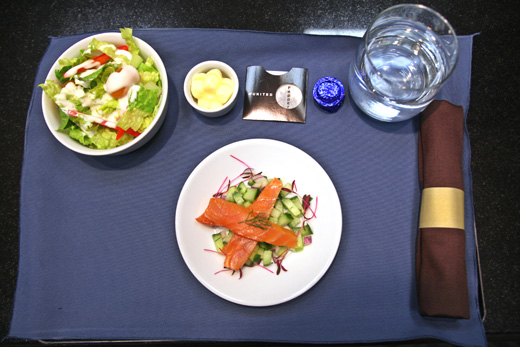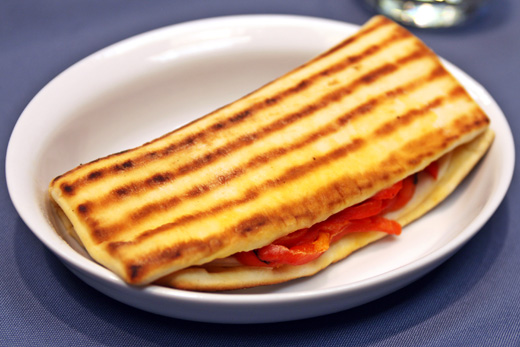United Airlines In-Flight Meals…they’ll change your view of airline food
Ask passengers about airline food and you’re bound to get two consistent answers
A) It’s horrible
B) Do airlines still serve meals?
Like the vast majority of passengers, I tend to fly in the back of the plane … where food is generally nonexistent or not exactly desirable … however “up front” in business class and first class many airlines are aggressively working to offer outstanding meal service to not only distinguish themselves from their competitors, but also win over ‘premium passengers.’
Back in June, I had the opportunity to explore exactly how United Airlines seeks to set its meal service apart from its competitors. Having flown United Airlines extensively, and in different classes of service both domestically and internationally, I was familiar with their meals and the difference in content between the classes of service, but the opportunity to sit down with their Executive Chef Gerry Gulli was an eye opener to the process of developing new meals.
As a passenger, regardless of the class of service we tend to sit in our seats and eat what is put in front of us. Staring at our tray we give little thought into how a meal is developed, how long it stays in rotation or the fact that a meal, especially in business and first class, must be fresh and plated in an attractive manner … all while being prepared by multiple catering facilities outside of the airline’s direct control.
The first thing that struck me about meeting with Chef Gulli is that the Chef had been with United Airlines for 25 years and that he had apprenticed as a Chef at the Ritz Carlton in Chicago. The thought of airline food and a chef that has worked in a five-star restaurant is not how most people envision the person created airline food menus. The background and experience of Chef Gulli has focusing on airline food is fantastic and once you taste his creations you’ll see why the airline’s meals stand out.
Airline food is not like restaurant food, and no restaurant serves the amount of meals an airline does in a single day … let alone without having control over those meals being created thousands of miles away from their kitchen.
First off .. when looking at airlines meals, lets look at cost. United Airlines presently spends more on average on each passenger’s meal than any other airline in the United States. Back in 2001, before the airline industry fell into massive financial hardships, American Airlines was spending the most on passenger meals, averaging US$8.50 a meal, while United was spending around US$8.10 per meal … by contrast at that same time Delta Air Lines was spending an average of US$4.15 per meal.
Now in 2010, United Airlines tops the average meal cost per passenger at around US$6.35 per meal, where as American Airlines averages US$5.80 a meal and Delta Air Lines comes in around US$5.00 per meal … and if you want to know who is at the bottom … it is US Airways averaging US$1.10 per meal per passenger.
Airline meals are not just thrown together or created from recycled ideas, For the premium passengers, in business and first class, the average time it takes to create, test and introduce a new meal is between two and three months, with most meals turning over around every two months.
The schedule of developing new dishes is constant, as is the very real challenge of creating items that not only taste excellent and have an impressive visual presence, but these meals must be able to be produced at remote facilities by third party carting companies, such as LSG Sky Chef and Gate Gourmet … and be prepared and plated in flight by flight attendants.
An interesting challenge for Chef Gulli and his team at United Airlines is creating dishes for different points of departure. The meals I was able to sample at United’s hub at Chicago O’Hare were made using cheeses local to Wisconsin, ingredients not available for meals departing from international departure points such as Tokyo’s Narita International Airport or Dubai International Airport. For international departing flights, an entirely new menu must be created and deployed using ingredients available at the points of departure by United Airlines that equal the quality and presentation of the meals being created for flights departing the U.S.
One very interesting aspect most consumers of airline means probably never think of is how heavy a meal is, or how ‘gassy’, a meal might be, all factors for feeding passengers traveling through time zones, eating at potentially irregular hours and remaining seated in a confined environment.
Meal choices to deal with time-zone shifts include offering not only full meals, with heavier foods, but also lighter meals, such as grilled sandwiches. Having landed countless times only an hour after falling asleep, I appreciate an airline that creates lighter meals allowing travelers to fill up, but keep moving as soon as they land in a more comfortable manner.
So next time you sit down and consume your in-flight meal, be it in economy class, business class, or first class, keep in mind all the factors that go into creating your in-flight meal.
Below are a few photos of each of meals I had the opportunity to sample with Chef Gulli of United Airlines (except the two fish dishes, as I am allergic). Each of the meals was served to me the way it would be served on a flight, including having been prepared between 12 and 24 hours prior to it being served to me. I also got lucky … and was the first non-United Airlines person to sample a new desert, the Chocolate-Chocolate Truffle … and all I can say is this “May I have seconds please?”
The meals below are below include Grilled Shrimp Brochette, Centercut Smoke Salmon Loin, Herbed Boursin Cheese Chicken with Pomegranate Glaze, Filet Mignon with Compound Butter, Hickory Smoked Turkey with Roasted Red Peppers on Flatbread and Grilled Chicken with Roasted Red Peppers and Spinach on Flatbread … and the Chocolate-Chocolate Truffle.
Happy Flying … and happy eating!









You need to learn how to use apostrophes. “You’re” does not mean “your”. It is a contraction of “you are”. “Its” does not mean “it is”; it is the possessive form of the word “it”. The proper contraction for “it is” is “it’s”.
Ignorance is bliss and a blessing in this context depending on how you look at it. To learn that a meal in business through to coach can cost so little casts doubt on quality. Who would want to sit in a Michelin starred eatery to find out that their meal cost less than the valet parking!
Perpetuating the long gone style and glamour of flying, circa the 1970’s, in the 21 century is no way to helps today’s traveler arrive well.
The majority of those who travel well and travel often eat as lightly as possible. Healthy flying needs a new conversation and it’s one that recognises that airplane food as it is today doesn’t contribute to travellers arriving well.
Arthur
I use spell check and sometimes it gets things wrong. I do not see the error you are referring to. Please tell me the paragraph and I’ll go in and correct it.
Happy Flying!
-Fish
I think he means “A) Its horrible”
ORD,
Thanks. One of these days I’ll stop trusting my spell checker, sometimes its spelling is worse than mine!
Happy Flying!
-Fish
I usually ask for special meal – Hindu Meal for me, when I travel in the front. After reading your post, I will have to go with the regular meal on my next trip… I think even the Buy on Board meals United has a for the folks in Coach are very good.
Great pictures too. I will post some of mine of the Hindu Meal when I get it next.
That steak plate looks good! mmmmm!
It tasted even better!
Happy Flying!
-Fish
Some airlines would do better with serving one of those instant noodle soups sold in Asian stores.
There’re carriers that even overfeed pax. Be it tasty or not. Yet, airline meals are still among the short-time goals when flying long-haul. Meal 1 – 2-3hrs after take off – some beverage/refreshment rounds here and then – snack/breakfast/meal 2 2-1 hr prior to landing.
I would be interested in knowing what year United Air Lines first put meals on their planes
Thank you,
Meryl Burkhardt
Meryl,
Having just conferred with United Airlines’ corporate communications folks, I was informed that United opened its first flight kitchen in 1936.
Happy Flying!
-Fish
Obviously written in 2010. Try flying United today. United has joined the non-existent club as far as food in domestic economy goes. But if you really want a chuckle, check out the food page in the July 2012 “Hemispheres” magazine. On the left side is a profile of one of United’s “Chef de Cuisine”, and on the right, his “menu selections”: Pringle’s, M&M, a container of yogurt all at outrageous prices that only a hopelessly trapped car of diners would pay. Le Chef is obviously a graduate of the Ecole du Snack du Vending Machine. No, one doesn’t expect haute cuisine on an flight, but the chintziness along with all the other nickel and diming makes the nightmare that flying has become even that much worse.
it really changes my mind after seeing such pictures & nice picture Thanks for share